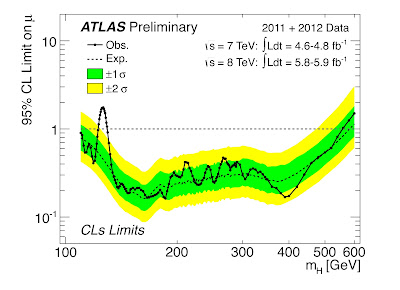Bad Scientist is a weblog updated weekly with news and thoughts about Science, Technology and various geekery.
Sunday, 15 July 2012
Forthnightly Science News Digest - 15/07/12
More hints towards the Higgs: as you might have already heard, there is lots of excitement in the field of Particle Physics because of a new discovery. As announced on a CERN seminar on 4 July, a new particle at 126 GeV of mass was discovered to 5-sigmas. The particle resembles a lot the Standard Model Higgs, which is a particle predicted by the Higgs mechanism. This model assumes that we live immersed in a field which gives mass to particles and the Higgs would be a ripple in this field, that can be detected at particle accelerators. It is not certain yet, though, if this new particle is the Higgs we are looking for. For more info about the discovery itself, you can check out my in-depth easy-language article.
Arsenic bacteria might not live without phosphorous after all: on December 2010, NASA claimed an extraordinary news, the news that life could substitute arsenic to phosphorous. There are 6 elements, without which life cannot exist, and phosphorous is one of them. Research by NASA showed that some bacteria were substituting phosphorous with arsenic and managing to live with arsenic. People were ready to "expand definition of life", but further research is showing that bacteria do not replace all the phosphorous with arsenic and there might be evidence that these bacteria cannot survive with no phosphorous at all. NASA stated that research is not complete yet.
Ocean acidification in California and CO2 in the atmosphere: scientists from Gruber's group investigate, using a model, the acidification of the waters near the California Current System, which are susceptible to ocean acidification. The increase of CO2 in the atmosphere threatens the health of the ocean and its variate ecosystem, changing the saturation state of Argonite. If you still doubt about CO2 high levels having an effect on Earth, science says they do: http://www.co2science.org/.
Magnetic cells isolated for the first time: magnetic cells are found in animals, such as birds and fishes. There are claims that these cells are used to perceive the Earth's magnetic field and have a sense of orientation (literally a sixth-sense based on magnetism). Walker et al. of the University of Auckland, performing studies on trout's nose cells, managed to isolate cells containing magnetite, which is the strongest magnet. The task was hard to accomplish because of the scarce availability of magnetic cells. As their magnetic field could interfere with each others one, each one of them is a distance apart, so only a few of those are found over a thousand normal cells. The magnetite found by the group was stronger than they expected and could also be used to get a sense of latitude and longitude (a small GPS). The next step is now to find whether this magnetic cells are linked to the brain and used for orientation.
Labels:
FSND
Subscribe to:
Post Comments (Atom)

No comments:
Post a Comment